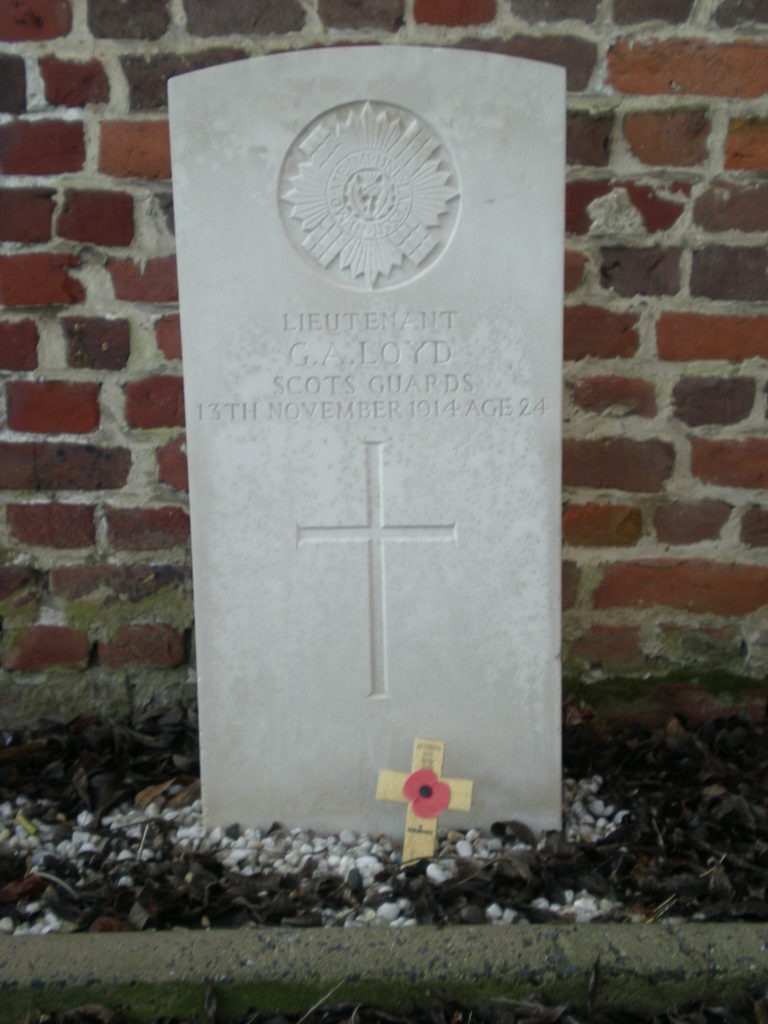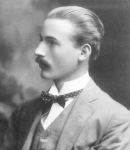Fact file:
Matriculated: 13 October 1909
Born: 22 January 1890
Died: 13 November 1914
Regiment: Scots Guards
Grave/Memorial: Poperinghe Communal Cemetery: I.B.4
Family background
b. 22 January 1890 in Chelsea, London, as the third son of Archie Kirkman Loyd, KC, DL, JP, MP (1847–1922) and Henrietta Louisa Loyd (née Clutterbuck) (1856–1931) (m. 1885). At the time of the 1891 Census the family (seven servants) lived at Milner Lodge, Cadogan Square, Chelsea, London SW; at the time of the 1901 Census the family (eight servants) lived at 60A, Cadogan Square, Chelsea, London SW; at the time of the 1911 Census the family lived at 21, Cadogan Square, Chelsea, London SW. It also had residences at Hardenhuish Park, Chippenham, Wiltshire, and Hendred Down House, East Hendred, Steventon, Berkshire.
Parents and antecedents
Loyd’s father, born in India, began his career in the Indian Civil Service, but was called to the Bar in 1863 and became a successful barrister, specializing in commercial law (with particular reference to bills of exchange, promissory notes, banknotes and cheques). He was Secretary of the Royal Commission (1880–81) which investigated corruption in Macclesfield elections (where 55 per cent of the electorate were found to have taken bribes) and whose findings led to the Corrupt Practices Act of 1883. He was a founder member and trustee of the National Aid Society, established in 1870 to assist the sick and wounded in war. He saw much work abroad with this society – during the Franco-Prussian War and in Turkey and Serbia – and was its Council’s Vice-Chairman when it became the British Red Cross Society (1905). He became a Queen’s Council in 1892. He was an original member of Lord Winchelsea’s Agricultural Union (1893) and its successor the Agricultural Organization Society (1901), groups that pressed for tax relief for agricultural land, the reduction of railway rates, and the provision of old age pensions. He actively pursued the same goals as Conservative MP for Abingdon (North Berkshire) (1895–1906 and August 1916–November 1918). He was for some time Deputy Lord Lieutenant of Berkshire, an Alderman of Berkshire County Council, and Chairman of North Berkshire Recruiting Officers’ Advisory Committee during World War One.
Loyd’s mother was the daughter of an officer in the Royal Horse Guards.
Siblings and their families
Brother of:
(1) Reginald Arthur (1886–1961);
(2) Robert Lindsay (later OBE, MC) (1887–1977), who married (1919) Olive Mary Gladstone (1893–1977), a grand-niece of William Ewart Gladstone (1809–1898) and daughter of Sir John Evelyn Gladstone, the 4th Baronet (1855–1945; one daughter); they lived at Bowden Park, Chippenham, Wiltshire;
(3) Wilfrid Haig (1896–1971); married (1921) Emily Charlotte Eileen Oakeley (1896–1978), daughter of Sir Charles John Oakeley, 5th Baronet Oakeley (1862–1938); three children.
Reginald Arthur read for a BA at Cambridge and was admitted to the Middle Temple on 9 November 1908. During the war he served as a Captain in the Remount Service in France and in 1927 he became the Land Tax Commissioner for Berkshire.
Robert Lindsay served in the 16th Lancers from 1900 to 1906 and rejoined as a Lieutenant in 1913. He served in France from 1914, where he was promoted Captain in the Royal Engineers and was attached to the Signalling Service from August 1914 to June 1915 and from August 1916 to January 1917. During this time he was mentioned in dispatches twice (London Gazette, no. 29,200, 18 June 1915, p. 5,982; no. 29,438, 11 January 1916, p. 584). On 14 January 1916 he was awarded the Military Cross (LG, no. 29,422, 31 December 1915, p. 14). From October 1917 to March 1918 and June to September 1918 he was Commandant of No. 3 Army Signalling School with the rank of Major. After the Armistice he was mentioned in dispatches for the third time (LG, no. 31,077, 17 December 1918, p. 14,936) and awarded the OBE (Military) on 1 January 1919 (LG, no. 31,092, 31 December 1918, p. 9). During the 1930s he served as a Major in the Life Guards and in 1937 and 1953 he was a recipient of the Coronation Medal.
He was a keen Mason, and in 1938 he was invested as a Knight in the Most Venerable Order of the Hospital of St John of Jerusalem. He later became Prior of the Provincial Priory of Oxfordshire, Berkshire and Buckinghamshire in the Religious, Military and Masonic Order of the Temple and of St John of Jerusalem, Palestine, Rhodes and Malta in England and Wales with Provinces Overseas. The Order is a royal order of chivalry that was established in Britain in 1831 and now exists throughout the Commonwealth, and in Hong Kong, Ireland and the USA. Its mission is “to prevent and relieve sickness and injury, and to act to enhance the health and well-being of people anywhere in the world” and as such, it is best known for its support of the St John Ambulance Brigade.
Wilfrid Haig was commissioned on 15 October 1914, promoted Lieutenant, and spent the war as a Staff Officer (Railway Traffic Officer in the Royal Engineers). In 1919 he was promoted to Temporary Captain on the General List. After the war he worked as a stockbroker and in 1935 he became Chairman of the Young Conservatives Union (1935). In 1942 he was re-commissioned as a Second Lieutenant so that he could work with the Army Cadet Force in Hampshire. In 1951 he was made an Officer of the Most Venerable Order of the Hospital of St John of Jerusalem.
Education
Loyd attended the Reverend Churchill’s School, Stonehouse, North Foreland, near Broadstairs, Kent (1884–1970; cf. W.G.S. Cadogan, B.O. Moon, A.H.E. Ashley), from c.1897 to 1903 and then Eton College from 1903 to 1908. He matriculated as a Commoner on 13 October 1909, having taken Responsions in Trinity 1909, but stayed at Magdalen only until March 1910, when he seems to have fallen ill and decided to leave without taking a degree. He was fond of rowing and hunting, and a member of the Guards’ Club, the Junior Army and Navy, and Pratt’s. After his death, President Warren described him as “an amiable, attractive young fellow, a very typical Etonian Commoner”. When making his will, he gave his address as 21, Cadogan Square, Middlesex, and the Guards Club, Pall Mall, London.
“An amiable, attractive young fellow, a very typical Etonian Commoner.”
Military and war service
Loyd became a Second Lieutenant on probation in the 2nd Battalion, the Scots Guards, on 4 February 1911 (cf. H.R. Inigo-Jones, W.G. Houldsworth and A. Graham-Menzies), and was confirmed in that rank on 1 February 1913. During the same year he rowed for his Regiment and coxed their VIII. In July 1914, while it was stationed at Aldershot, Loyd was put in charge of the Cyclist Platoon of the 4th Guards Brigade, part of the Mounted Troops of the 2nd Infantry Division, and promoted Lieutenant on 24 September 1914. The unit set off for France on 12 August 1914, disembarked on the following day, and took part in the Retreat from Mons, the 1st Battle of the Marne and the Battle of the Aisne: for his “accurate reconnaissance and liaison work” during the first of those actions, Loyd was awarded the Croix de Chevalier de la Légion d’Honneur on 6 September 1914. But on 13 November 1914 he was mortally wounded by shrapnel at Zonnebeke, east of Ypres, when his Company was escorting four 50-pounder siege howitzers, probably belonging to 35th Heavy Battery, Royal Garrison Artillery, that were withdrawing slightly from an exposed position east of Zonnebeke and holding an entrenched position under heavy shell fire. He died the same day of wounds received in action in No. 4 Casualty Clearing Station at Poperinghe, aged 24. He was mentioned in dispatches in Sir John French’s Dispatch of 31 January 1915 (London Gazette, no. 29,072, 16 February 1915, p. 1,658). He was buried in Poperinghe Communal Cemetery (Rekhof, near the town centre), Grave I.B.4. He is commemorated on Easton Hastings memorial, Oxfordshire. He died intestate, but his estate was valued at £156.
Bibliography
For the books and archives referred to here in short form, refer to the Slow Dusk Bibliography and Archival Sources.
Printed sources:
[Anon.], The Times [untitled obituary], no. 40,707 (25 November 1914), p. 10.
[Thomas Herbert Warren], ‘Oxford’s Sacrifice’ [obituary], The Oxford Magazine, 33, no. 7 (27 November 1914), p. 103.
Eton College Chronicle, no. 1,511 (16 December 1914), p. 708.
[Anon.], ‘Lieut. Geoffrey Archibald Loyd’, The Bond of Sacrifice, 1 (1914), p. ????.
Clutterbuck, i (1915), pp. 234–5.
[Anon.], ‘Obituary’, The Times, no. 43,204 (2 December 1922), p. 12.
Leinster-Mackay (1984), pp. 172, 297.
Archival sources:
MCA: Ms. 876 (III), vol. 2.
OUA: UR 2/1/69.
WO95/1283.
WO95/1324.
WO95/1657.
WO339/7802.



